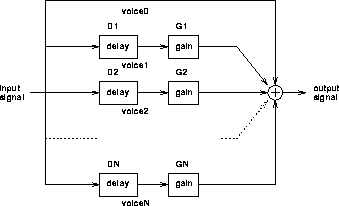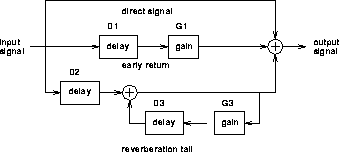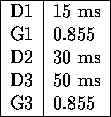
EECS20: Introduction to Real-Time Digital Systems
Lab04: Digital Audio Effects
EECS20: Introduction to Real-Time Digital Systems
©1996 Regents of the University of California.
By K. H. Chiang, William T. Huang, Brian L. Evans.
URL: http://www-inst.eecs.berkeley.edu/~ee20
News: ucb.class.ee20
In the last laboratory, you played music as a sequence of notes, and experimented with making the music sound more realistic. In this laboratory, you will use simple mathematical operations to add style and special effects to the computer-generated music. You will add vibrato and tremelo playing styles. For special effects, you will replicate a melody to sound as if it were coming from many similar instruments (chorusing), and incorporate echo and reverberation, which are feedback techniques employed often in rock 'n' roll.
Vibrato is the variation of the amplitude of a tone by a low frequency sine wave. In mathematical terms:

where  is the frequency of the underlying sine wave, or the carrier
frequency;
is the frequency of the underlying sine wave, or the carrier
frequency;  is the modulating frequency, with
is the modulating frequency, with  ; and
; and
 is the sampling frequency, with
is the sampling frequency, with  to ensure that the Nyquist
criterion is satisfied.
to ensure that the Nyquist
criterion is satisfied.
Tremelo is the variation of the frequency of the tone by a low frequency sine wave. In mathematical terms:

where  is the frequency of the underlying sine wave, or the carrier
frequency;
is the frequency of the underlying sine wave, or the carrier
frequency;  is the modulating frequency. with
is the modulating frequency. with  ;
;  is
the modulation index, and
is
the modulation index, and  is the sampling frequency, with
is the sampling frequency, with  to
ensure that the Nyquist criterion is satisfied. To get a feel for what these
parameters actually do, graph the frequency
to
ensure that the Nyquist criterion is satisfied. To get a feel for what these
parameters actually do, graph the frequency  as a
function of time
as a
function of time  ; the frequency will have a nominal value of
; the frequency will have a nominal value of  , but
will exhibit a sinusoidal variation at a frequency of
, but
will exhibit a sinusoidal variation at a frequency of  with a maximum
amplitude of
with a maximum
amplitude of  . Suggested values of
. Suggested values of  will be on the order of 2.5% to
10% of
will be on the order of 2.5% to
10% of  .
.
Varying the amplitude of a sine wave by some signal is commonly called amplitude modulation. Varying the frequency of a sine wave by some signal is
commonly called frequency modulation. In frequency modulated (FM) radio,
 ranges from 88.5 to 108.5 MHz, the maximum
ranges from 88.5 to 108.5 MHz, the maximum  is 15 kHz, and
is 15 kHz, and  .
In amplitude modulated (AM) radio,
.
In amplitude modulated (AM) radio,  is 530 to 1700
is 530 to 1700  100 kHz and
the maximum
100 kHz and
the maximum  is 5 kHz. This is one of the reasons that music on an FM
radio station sounds better- more of the frequencies in the music are being
transmitted. AM radio carries enough frequencies for human speech to sound
good, but not enough for music because music contains frequencies over the
entire audible range from 20 Hz to 20 kHz.
is 5 kHz. This is one of the reasons that music on an FM
radio station sounds better- more of the frequencies in the music are being
transmitted. AM radio carries enough frequencies for human speech to sound
good, but not enough for music because music contains frequencies over the
entire audible range from 20 Hz to 20 kHz.
One way that studios use to make a few people sound like a crowd is chorusing. This is done adding to the original signal several delayed and attenuated versions of the original signal, as illustrated in Figure 1.

Figure 1: A system that implements chorusing.
The arrows in the figure indicate paths for the input signal. Figures such as these are usually drawn with the signal flow from left to right. Blocks represent systems which operate on their inputs to produce outputs. The delay blocks will return delayed versions of their inputs; in Figure 1, the amount of delay is represented by the variables D1 through DN. The gain blocks multiply their input by a constant value; this constant value is denoted G1 through GN. The circle with the plus sign is an adder, whose output is the sum of its inputs.
Consider clapping your hands once in a large room. First you hear the clap, and then an attenuated version of that clap, and then an attenuated version of that attenuated version... One way to reproduce this effect in the lab is to use a feedback loop, as in Figure 2.

Figure 2: A system that implements echo.
The input to the system is the original signal and the output is the echoed signal. Note that there is a direct connection from the input to the output. However, there is also a connection feeding a delayed and attenuated [assuming the gain is less than unity] version of the output signal back into the input. This is called a feedback loop, because the output is fed back to the input.
This system can be directly realized by summing appropriately delayed and
attenuated copies of the original signal. Let the original signal be denoted
 , sampled at rate
, sampled at rate  . If we desire a delay of
. If we desire a delay of  seconds, this
translates into a delay of
seconds, this
translates into a delay of  samples. In addition, if the attenuation
factor is denoted
samples. In addition, if the attenuation
factor is denoted  , the signal with echoes
, the signal with echoes  is then:
is then:

If the delay in the echo system above is sufficiently small, we can no longer hear distinct echoes. With a few appropriate modifications, as described below, we instead have reverberation.
Reverberation is the combination of a direct sound, an early return, and a reverberation tail. Going back to our example of clapping in a room, the direct sound is the initial clap. The early return would be the first echo that you would hear. The reverberation tail would be all the other echoes coming back to your ears, except that they would be close enough together that they wouldn't be very distinct. A simple reverberation system is shown in Figure 3.

Figure 3: A system that implements reverb.
With the appropriate selection of the parameters in Figure 3, we can simulate the response of any room from a dead one [with no return at all; this would be a room with a lot of sound insulation on the walls] to an extremely lively one [like a stadium or church].
Of course, the key word here is ``appropriate''. From the data available on
various acoustical spaces, two of the available parameters are initial time
delay (ITD) and reverberation time. The ITD is the time between when you make
a sound and when you hear the first echo. The reverberation time is the time
it takes for a sound that you make at  to die away to
to die away to  of
its initial amplitude.
of
its initial amplitude.
Relating the ITD and the reverberation time to the values you need to put into the system in Figure 3 is a matter of engineering discipline [translation: make a reasonable guess]. As far as i can make it out, rules of thumb for choosing the various values are as follows:
 .
.
 .
.
For Symphony Hall in Boston, MA, the ITD is  and the reverberation time
is
and the reverberation time
is  if the hall is occupied. This translates into:
if the hall is occupied. This translates into:

 tone. Use
tone. Use
 , and for tremelo, a modulation index of 1.
, and for tremelo, a modulation index of 1.
sound command. Can you hear
any difference between them?
 [you may wish to change this maximum value]. For the various gains,
choose values between
[you may wish to change this maximum value]. For the various gains,
choose values between  and
and  .
.

Read the documentation for the filter command. Use that command with
b=[1],a=[1 zeros(1, delay-1) -alpha], and a sufficiently long copy of x,
padded with zeros. Compare the resulting output with that directly generated.
Note that the filter command could take a long time to run, especially for
large values of  .
.
